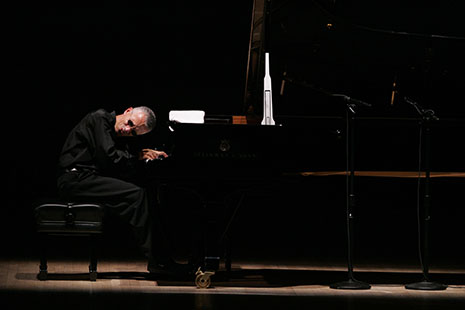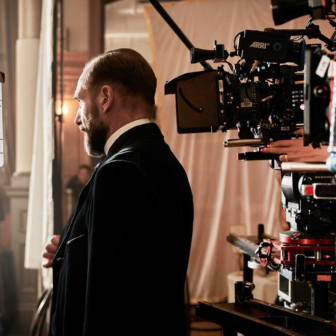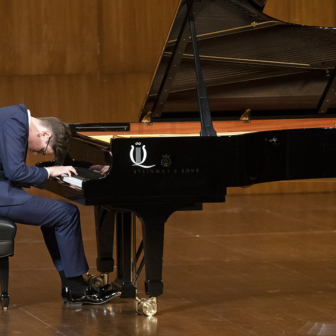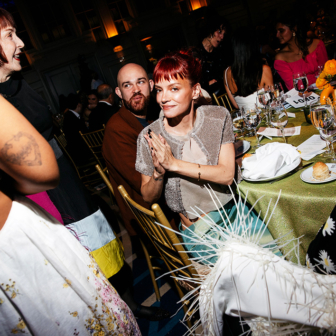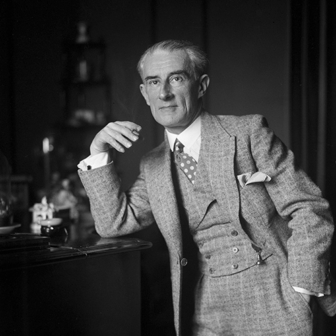TOWARDS THE END of a track on his newly released trio recording, Yesterdays, pianist Keith Jarrett plays a melodic phrase that sounds as though it has escaped from the Oasis song “Wonderwall.” It brings the listener up short, because of course Jarrett is not that kind of jazz musician. Younger players such as Brad Mehldau might tap pop music from Paul Simon to Radiohead, or even “Wonderwall” itself, in search of potential new standards, but Jarrett remains a traditionalist. His idea of a standard is little different from Bud Powell’s or Bill Evans’s. It’s either a classic bebop tune by the likes of Charlie Parker, Thelonious Monk or Powell himself or it’s from the Broadway/Tin Pan Alley pantheon of composers such as Richard Rodgers, Harold Arlen and Jerome Kern. Certainly nothing much after the 1950s. On Yesterdays, it is actually Kern’s “Smoke Gets in Your Eyes” (from 1933) that yields the presumably unwitting fragment of “Wonderwall.”
The concept of the standard has long been a matter of contention in jazz circles. Most concepts in jazz are more or less contentious – jazz musicians and, particularly, jazz fans are an opinionated lot – but the standard is something of a special case, because it goes to the heart of the matter. Jazz is an improvised music and, some say, it should pour out of its performers, spontaneous, free and unhampered by a dependency on the harmonic template of a song composed eighty years ago by George Gershwin. Others would argue that if the music is merely spontaneous and free there is no special reason to label it jazz. It is only the templates – harmonic, melodic, stylistic, instrumental – that situate the music within that particular genre. And anyway, knowing your standards is to jazz musicians what drawing is to visual artists. It’s a training; it keeps them honest. You see why this is contentious. And since no one in this discussion is actually right or wrong, the contention will always continue and much time will be wasted.
In one sense, however, standards really are like drawing. If you ask a group of very different artists to draw the same vase of flowers, you will quickly discover their various aesthetic preferences, their technical differences and similarities, even the contrasting ways in which they see a bunch of peonies in water. It’s much the same with jazz musicians. The rich variety of jazz available today can seem baffling in its stylistic range. The neophyte can listen to half a dozen different players and quickly get lost in the range of styles and approaches. But ask those same six players to give you their versions of “Polka Dots and Moonbeams” and you gain perspective, you hear exactly where they’re coming from. And because players tend to have their favourite standards, tunes to which they return over their whole career, it is also possible to gain a historical perspective, to hear a player changing across ten, twenty or thirty years or, perhaps, within the space of a few days.
It is now twenty-six years since Jarrett first invited bassist Gary Peacock and drummer Jack DeJohnette to record standards with him and in that time twenty trio albums have been released on ECM, including a few that contain free improvisations. Over the years quite a few tunes have returned like old friends. A short list of Jarrett favourites might include “Autumn Leaves,” “When I Fall in Love,” “If I Were a Bell,” “My Funny Valentine,” “Things Ain’t What They Used to Be,” “You Took Advantage of Me,” “Scrapple from the Apple,” “Smoke Gets in Your Eyes” and “Stella by Starlight,” the last four of which, in fact, turn up on Yesterdays.
Most of Jarrett’s albums are recorded in concert. All the tracks on Yesterdays come from a Tokyo concert in April 2001 (the final track was actually recorded at the sound check), and it’s worth noting that four of Jarrett’s last five trio albums have come from concerts in that same year. We might infer that the trio was on something of a roll. Certainly here it’s in very good form indeed, alternately exploring the lyricism of Carl Fischer’s “You’ve Changed” (with a lovely, loping, melodic bass solo from Peacock), “Smoke Gets in Your Eyes” and the album’s title track, and energetically displaying its bebop credentials on tunes by Parker, Dizzy Gillespie and Horace Silver. One of the particular delights of the recording is the way in which Jarrett and his colleagues demonstrate the line that runs from bebop back to ragtime. On Gillespie and Parker’s “Shaw’nuff,” for example, Jarrett’s left hand goes in for some athletic stride playing, while Rodgers and Hart’s “You Took Advantage of Me” begins as pure ragtime, moving gradually into a fast bop workout – a manic real-time analysis of the tune’s melodic and harmonic nuts and bolts – before slipping back into ragtime. (The trio performed a similar feat with the same tune, though at a slower tempo, on their previous release, My Foolish Heart: Live at Montreux, also recorded in 2001 but three months after the Tokyo session on Yesterdays.)
“You Took Advantage of Me” was composed in 1928 for a Busby Berkeley show, Present Arms, and it has its roots in ragtime. Jarrett’s approach, then, is historically apt. But in mixing up the syncopations of ragtime and bop, Jarrett is also demonstrating a belief in the oneness of jazz, and this philosophy seems to lie at the very heart of his playing, even when he is unaware of it or wants to repudiate it. It is certainly at the heart of his solo playing.
WHEN JARRETT is not working with his standards trio, he plays solo improvisations. Indeed he is probably more famous for these than for his work with the trio, simply because what he does here has a sensational, even gladiatorial quality. Alone on stage with nothing in mind, Jarrett coaxes and coerces sounds from his piano that will send him off on a unique journey of musical exploration. On the face of it, this is the polar opposite of playing standards and Jarrett himself is most insistent that not only does he not know where he is headed at the start of the evening, but at the end he doesn’t know where he has been. He enters something approaching a trance-like state in which his characteristic high-pitched vocalisations are as involuntary as his writhing on the piano stool and occasional levitations over the keyboard. When he listens back to a recording of the event, he is as interested to hear what he has created as his audience was on the night.
In the documentary film Keith Jarrett: The Art of Improvisation (2005), the pianist stresses that the music he plays in these concerts comes from him alone: Jarrett’s mind in Jarrett’s body is sending impulses to Jarrett’s fingers: there is no will involved, no conscious choices being made. The pianist will have no truck with the idea that all music is about other music: these improvisations, he maintains, give the lie to that piece of mythology.
Well, yes and no. André Malraux once pointed out that no one becomes a painter by looking at landscapes. You become a painter by looking at paintings. It is no different with music. Other music lies behind it. Doubtless Jarrett’s state of mind and physical fitness on the day contribute to his improvisations, as does the nature of the piano at which he is sitting, the design and acoustic of the hall, and – most important of all – the more or less palpable intensity of the listening from the audience. (Jarrett is famously sensitive to the last.) All these things are significant, and yet however good Jarrett is feeling on the night and however hard the audience is willing him on, one note must still be placed after another. It is not as though Jarrett’s fingers are producing music the like of which has never before existed. On the contrary, the meters and rhythms, textures and harmonies, chordal voicings and melodic contours that emerge from one of these improvisations can almost always be traced back to earlier music. If the memory is able to function while we sleep, dredging up images and sounds in the form of dreams, it can certainly contribute to a piano improvisation, no matter how much the player might be “in the moment.”
Jarrett’s solo improvisations also draw on what we might think of as “standards.” These are forms, styles and archetypes that are as much a part of this pianist’s make-up as a knowledge of the chord changes in old Victor Young tunes. Jarrett might not be conscious that he is mining the rich seams of American musical history, but that, in part, is surely what he is doing. At a performance at the Vienna State Opera in July 1991 – on a CD called simply Keith Jarrett: Vienna Concert – the opening chords conjure the luminous, white-note harmonies of Aaron Copland, who himself drew on older templates such as New England hymnody and Appalachian (Celtic) folk song. This type of music often turns up in Jarrett’s improvisations, sometimes forming the “still centre” of his “turning world,” sometimes, as in Vienna, providing the launching pad for an astonishing display of spontaneous musical invention that leads to faster, busier, louder, more complex, more rhythmically driven music, before subsiding into a lengthy and still more hymn-like coda.
Jarrett’s improvisations are a subtle compendium of American style. Jazz from ragtime to bebop to cool at some level underpins most of his playing. Blues harmonies are regular visitors. Even the minimalism of Steve Reich and Philip Glass rears its head when Jarrett seizes on a particular riff and locks it into a holding pattern. Of course other, less obviously American templates also turn up on some nights. On the Vienna Concert CD, for example, the second improvisation begins with a scale that might be Japanese and later leads to harmonies redolent of Arvo Pärt, a composer whose music Jarrett (in classical mode) has played and recorded. His long involvement with Bach’s music is also surely relevant when it comes to his ability to improvise intricate counterpoint.
In Tokyo’s Metropolitan Festival Hall in October 2002 – on a DVD entitled Keith Jarrett: Tokyo Solo – the performance kicks off with a passage of atonal counterpoint that sounds rather like a randomised reimagining of one of the more complex passages of Schoenberg’s Piano Concerto (we shouldn’t forget that even this is an American piece, composed in 1942 in Hollywood). This passage is another staggeringly impressive piece of invention from the pianist, all the more so for coming out of the blue. He walks on stage, sits down and out come thousands of notes, each one perfectly placed and apparently judged – if spontaneous judgement isn’t too much of a paradox – to produce a thrillingly nervy, edge-of-the-seat effect. But once again the music eventually comes to rest in a sort of Coplandesque reverie. There are usually moments of balm in a Jarrett performance and they often feature block chords moving stepwise as in a hymn, emphasising a gentle modality and often enough giving rise to a melodic line that seems to belong to the ages. And of course it does. That is the point. He may not know it and may wish to deny it, but Jarrett can hardly avoid tradition.
Like Tennyson’s Ulysses – and like the rest of us – Keith Jarrett is a part of all that he has met. He might enter a state of unknowing at the beginning of a night of improvised music, but everything he has learned and experienced lies deep in his memory, ready to colour his spontaneous outpourings and to help make sense of them. Just as conventional standards provide context and perspective in jazz, so these archetypal “standards” bring perspective to these improvisations. For the art of improvisation – like the art of its far slower and more painstaking counterpart, composition – is also the art of memory, however subconscious. •
